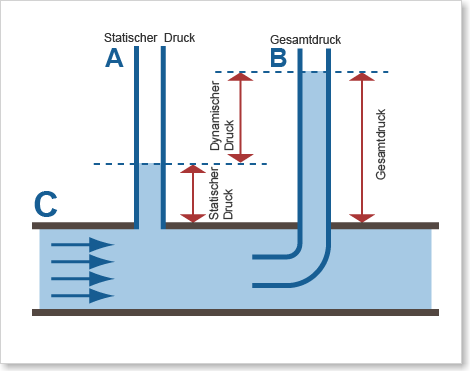Furthermore, in the fan art are two important equations:
See more room tips
See more room tips
They say something about so-called ideal flow of gases or liquids, ie, flow without friction.Bernoulli's equation and the The continuity equation
The equation of Bernoulli
Pressure is - as just seen on the page about development pressure - a condition variable, which describes the force acting on a surface.
In pipelines, in which water flows or air, it is a little more complex . Here the pressure is divided into two parts: the static and the dynamic pressure.
In pipelines, in which water flows or air, it is a little more complex . Here the pressure is divided into two parts: the static and the dynamic pressure.
experimental arrangement
To measure this, we can build the following test set (we stay with the example of water, but the result is equally applicable also to an air flow).
One takes a tube (C), passes through the water. To the two small tube, open at both ends, test tubes A and B are attached.
The lower opening of the tube A is parallel to the flow direction on the outer wall of the tube C. The lower opening of the tube B is located in the tube C and displays its opening against the direction of flow. Now is clearly seen that in the two tubes, the fluid levels are different heights, which suggests to different pressures.
Tube A shows the static pressure in the water, B is the total pressure tube.
Subtracting the static pressure from total pressure , we obtain the dynamic pressure .
One takes a tube (C), passes through the water. To the two small tube, open at both ends, test tubes A and B are attached.
The lower opening of the tube A is parallel to the flow direction on the outer wall of the tube C. The lower opening of the tube B is located in the tube C and displays its opening against the direction of flow. Now is clearly seen that in the two tubes, the fluid levels are different heights, which suggests to different pressures.
Tube A shows the static pressure in the water, B is the total pressure tube.
Subtracting the static pressure from total pressure , we obtain the dynamic pressure .

The Bernoulli's equation says that the total pressure always equal to remains, only the shares of the static and dynamic pressure change. If the one to the other decreases by the same amount.
Transferred to the fans, it can be said that the static pressure to be overcome by the fan pressure resistance of the system is. The static pressure indicates which pressure can build up the fan without air flow (flow = 0).
The air flows is in addition carried out nor the dynamic pressure.




